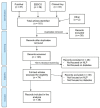Using Natural Language Processing to Measure and Improve Quality of Diabetes Care: A Systematic Review
- PMID: 33736486
- PMCID: PMC8120048
- DOI: 10.1177/19322968211000831
Using Natural Language Processing to Measure and Improve Quality of Diabetes Care: A Systematic Review
Abstract
Background: Real-world evidence research plays an increasingly important role in diabetes care. However, a large fraction of real-world data are "locked" in narrative format. Natural language processing (NLP) technology offers a solution for analysis of narrative electronic data.
Methods: We conducted a systematic review of studies of NLP technology focused on diabetes. Articles published prior to June 2020 were included.
Results: We included 38 studies in the analysis. The majority (24; 63.2%) described only development of NLP tools; the remainder used NLP tools to conduct clinical research. A large fraction (17; 44.7%) of studies focused on identification of patients with diabetes; the rest covered a broad range of subjects that included hypoglycemia, lifestyle counseling, diabetic kidney disease, insulin therapy and others. The mean F1 score for all studies where it was available was 0.882. It tended to be lower (0.817) in studies of more linguistically complex concepts. Seven studies reported findings with potential implications for improving delivery of diabetes care.
Conclusion: Research in NLP technology to study diabetes is growing quickly, although challenges (e.g. in analysis of more linguistically complex concepts) remain. Its potential to deliver evidence on treatment and improving quality of diabetes care is demonstrated by a number of studies. Further growth in this area would be aided by deeper collaboration between developers and end-users of natural language processing tools as well as by broader sharing of the tools themselves and related resources.
Keywords: diabetes; electronic health records; natural language processing.
Conflict of interest statement
References
-
- Sherman RE, Anderson SA, Dal Pan GJ, et al.. Real-world evidence: what is it and what can it tell us? N Engl J Med. 2016;375(23):2293-2297. - PubMed
-
- Krause JH, Saver RS. Real-world evidence in the real world: beyond the FDA. Am J Law Med. 2018;44(2-3):161-179. - PubMed
-
- Califf RM, Robb MA, Bindman AB, et al.. Transforming evidence generation to support health and health care decisions. N Engl J Med. 2016;375(24):2395-2400. - PubMed
Publication types
MeSH terms
LinkOut - more resources
Full Text Sources
Other Literature Sources
Medical


